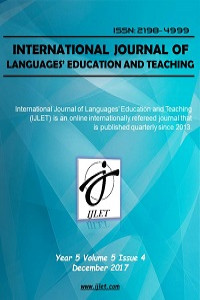Abstract
In an English Foreign Language learning context, where access to native like use of metaphorical language is limited, gaining this ability becomes challenging. For many years, foreign language educators didn’t pay much attention to idiomatic language and assumed that idioms could only be taught through rote learning. For this reason, they face with difficulties in using appropriate approaches to idiom instruction. Furthermore, learners struggle with comprehending and practicing idioms. To resolve the concern, linguists are trying to develop cognitive approaches to the teaching of idiomatic language. The purpose of this study is to provide educators with guidelines to choose the appropriate idiom teaching technique for English Foreign Language learners taking into account the learners’ metaphorical competence level and their cognitive style preferences. In evaluating the appropriate teaching technique, three different techniques (context out, context in and mental imaging technique) were used. The participants were presented 50 idioms. As a first technique, context out, idioms were taught with their definitions in the dictionary without additional contextual support. As a second technique, context in, in an attempt to investigate the effect of contextual support, idioms were both presented in a sentence and with their definitions. As a third technique, mental imaging technique, in an attempt to investigate the effect of Dual Coding approach, both pictorial representations of a mapping of literal senses of each idiomatic expression and verbal support (the definition of the idiom and the sentence in which the idiom is used) were used concurrently. The findings point that mental imaging technique has positive effect on learning and recalling of the idiomatic expressions as it provides simultaneous verbal information with mental image which creates a supplementary pathway for recollecting the verbal information. In contrast, the results indicate no effect of preferred cognitive style on idiom learning and recalling among intervention groups.
References
- Abel, B. (2003). English idioms in the first and second language lexicon: A dual representation approach. Second Language Research, 19(4), 329–58.
- Baddeley, A. D. (1999). Essentials of Human Memory. UK: Psychology Press.
- Boers, F. (2004). Expanding Learners’ Vocabulary Through Metaphor Awareness: What Expansion, What Learners, What Vocabulary?. In M. Achard, S. Niemeler (Eds.), Cognitive Linguistics, Second Language Acquisition, and Foreign Language Teaching (pp. 211-232). Berlin: Mouton de Gruyter.
- Boers, F., Eyckmans, J., & Stengers, H. (2007). Presenting figurative idioms with a touch of etymology: More than mere mnemonics?. Language Teaching Research, 11(1), 43–62.
- Boers, F., Piriz, A.H.J., Stengers, H., Eyckmans, J. (2009). Does pictorial elucidation foster recollection of idioms?. Language Teaching Research, 13(4), 367-382.
- Cieślicka, A. (2006). Literal salience in on-line processing of idiomatic expressions by second language learners. Second Language Research, 22(2), 115–144.
- Cieślicka, A. B. (2013). Second language learners’ processing of idiomatic expressions: Does compositionality matter?, In Drozdzial-Szelest, K., & Pawlak, M. (Eds.), Psycholinguistics and Sociolinguistic Perspectives on Second Language Learning and Teaching (pp. 115–136). Berlin: Springer.
- Clark J. M. & Paivio A. (1991). Dual Coding Theory and Education. Educational Psychology Review, 3(3), 149-210.
- Cuevas, J. (2016). An analysis of current evidence supporting two alternate learning models: learning styles and dual coding. Journal of Educational Sciences and Psychology, 6(1), 1-13.
Abstract
References
- Abel, B. (2003). English idioms in the first and second language lexicon: A dual representation approach. Second Language Research, 19(4), 329–58.
- Baddeley, A. D. (1999). Essentials of Human Memory. UK: Psychology Press.
- Boers, F. (2004). Expanding Learners’ Vocabulary Through Metaphor Awareness: What Expansion, What Learners, What Vocabulary?. In M. Achard, S. Niemeler (Eds.), Cognitive Linguistics, Second Language Acquisition, and Foreign Language Teaching (pp. 211-232). Berlin: Mouton de Gruyter.
- Boers, F., Eyckmans, J., & Stengers, H. (2007). Presenting figurative idioms with a touch of etymology: More than mere mnemonics?. Language Teaching Research, 11(1), 43–62.
- Boers, F., Piriz, A.H.J., Stengers, H., Eyckmans, J. (2009). Does pictorial elucidation foster recollection of idioms?. Language Teaching Research, 13(4), 367-382.
- Cieślicka, A. (2006). Literal salience in on-line processing of idiomatic expressions by second language learners. Second Language Research, 22(2), 115–144.
- Cieślicka, A. B. (2013). Second language learners’ processing of idiomatic expressions: Does compositionality matter?, In Drozdzial-Szelest, K., & Pawlak, M. (Eds.), Psycholinguistics and Sociolinguistic Perspectives on Second Language Learning and Teaching (pp. 115–136). Berlin: Springer.
- Clark J. M. & Paivio A. (1991). Dual Coding Theory and Education. Educational Psychology Review, 3(3), 149-210.
- Cuevas, J. (2016). An analysis of current evidence supporting two alternate learning models: learning styles and dual coding. Journal of Educational Sciences and Psychology, 6(1), 1-13.
Details
| Primary Language | English |
|---|---|
| Subjects | English As A Second Language, Language Studies (Other) |
| Journal Section | Research Article |
| Authors | |
| Publication Date | December 30, 2017 |
| Published in Issue | Year 2017 Volume: 5 Issue: 4 |


